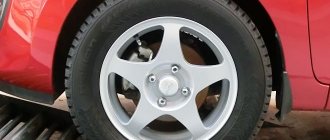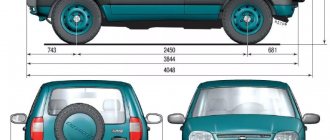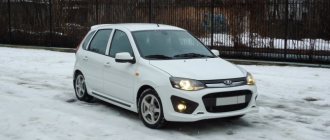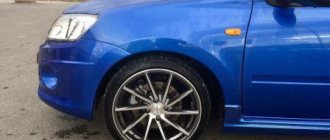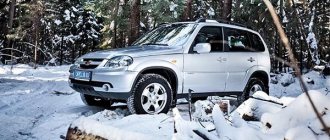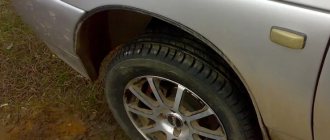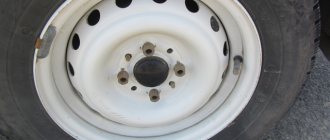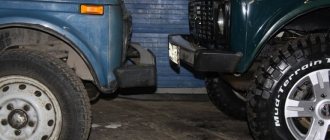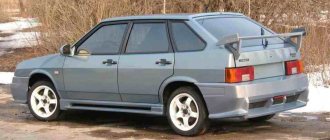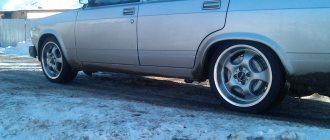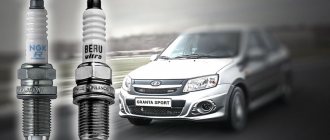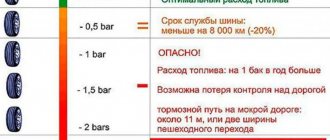Select modification VAZ 2109
Despite the fact that this information is taken from the websites of auto manufacturers, our catalog is for informational purposes only and does not guarantee full compliance of the proposed sizes with your car.
Source razboltovka.ru
Many owners of Nines and Tens would probably like to purchase alloy wheels for their VAZs. Indeed, this type of external tuning is the least expensive and can be easily done even with your own hands. Alloy wheels on the VAZ 2109 and VAZ 2110, without problems or any negative consequences for the car, can be installed in three sizes: R13, R14 and R15.
You can, of course, try to fit “rollers” with a larger diameter, but at the same time you cannot avoid serious alterations in the design of the car, which will additionally cost the car owner a “tidy” sum.
At the end of this article you will find a table with the sizes of tires and alloy wheels that can be installed on VAZ 2108, 2109, 21099, 2110 cars.
It is also worth paying attention to our visual tire calculator.
Below we have described the main advantages and disadvantages of various combinations of tires and rims for VAZ 2109 and VAZ 2110 cars (and their modifications), which can be installed without any modifications to the car.
Other settings
In addition to the basic characteristics of the tire and wheel, there are other important indicators that must be taken into account. One of them is wheel offset, which is the distance from the wheel hub to the middle of the rim.
You can also increase the car's ground clearance using spacers for shock absorbers. You can install them yourself. Then the offset can be made smaller, but its deviation from the recommended one leads to a change in the load on the hub bearing. This will result in a reduction in its service life and affect the controllability of the car.
The offset can be made less than recommended for wide rims. If the discs are narrow, then you can take more. To make the right choice, it is advisable to seek help from a specialist, from whom you will receive precise instructions on what parameters are needed. When purchasing disks, it is extremely important to accurately select the mounting dimensions for the mounting bolts and nuts (PCD). If the choice is made even with a slight error, a disc with a slight PCD deviation that is not visually noticeable can be installed on the hub. Then some bolts will fit exactly, while others will fit misaligned. Such a wheel will begin to “figure eight”, and the nuts will spontaneously unscrew.
What size alloy wheels and tires can be installed on VAZ cars?
The most popular size of alloy wheels on VAZ cars are wheels with a diameter of 14 inches (R14). However, when installing wheels with a diameter different from the factory ones, you must comply with the width and offset set by the car manufacturer. If these parameters are significantly exceeded, then in turns and when the car is fully loaded, the protruding wheels will constantly rub against the fender liners, touching the wheel arches and parts of the car’s suspension.
On Samaras (VAZ 2108, 2109, 21093, 21099) difficulties often arise with the rear wheels - enlarged wheels quite often “conflict” with the wheel arches and elements of the car’s suspension. Therefore, before purchasing, you should make sure that the sizes of alloy wheels you have chosen will not cause problems after they are installed on the car.
Normal and fairly wide alloy wheels on the VAZ 2108, 2109, 21093, 21099 can be, for example, 6 inches wide (J6.0) with an offset (indicated by ET) of 35-40 mm . For such wheels, standard VAZ 2110 tires (size 175/65 R14) are suitable, but tires with a width of 165 or 185 millimeters are also acceptable.
Explanation of symbols on tires and wheels can be found here:
In addition, the “eights” and “nines” can be equipped with 15-inch alloy wheels with low-profile tires. But then the offset should be within 30-35 mm, and the tires, for example, should be 185/55 R15 or 195/50 R15. Installation of tires of size 195/55 R15 or 205/50 R15 is possible only on the front axle, because rear wheels with this diameter will require additional modifications to the suspension and wheel arches.
tires of sizes 185/60 R14 and 195/50 R15 performed best on alloy wheels installed on VAZ 2108, 2109, 21093, 21099 vehicles . But this does not mean at all that other combinations of alloy wheel and tire sizes are not suitable for your VAZ.
It will also be useful to know that for all VAZ alloy wheels in the catalogs there is such a parameter as PSD 4x98 . It means that four bolts inscribed in a circle with a diameter of 98 millimeters are used to secure the wheel rim to the hub. And the diameter of the central hole of all alloy wheels on a VAZ must be at least 58.5 millimeters.
Changing the outer diameter of the wheel
For the VAZ 2109, they usually try to take the recommended wheel sizes or a little larger, as far as the arch design allows. When installing wheels with a smaller diameter on a car, noise is reduced and acceleration dynamics are increased. As a result, more shortcomings appear: the vehicle’s ground clearance decreases, the maximum speed decreases, the speedometer begins to “twist”, and road grip deteriorates.
The maximum wheel width on a VAZ 2109 is 195 mm. The next size is 205 mm and this is already exceeding the limit. The wide tire begins to touch the arches and they need to be trimmed. Numerous videos and photos on the Internet show that this is quite a difficult job.
Increasing the outer diameter of the wheel, if it does not interfere with driving, eliminates all of the above disadvantages, but then acceleration worsens. The load on the steering wheel also increases, and this is noticeable since there is no power steering.
Advantages and disadvantages of low profile tires
With low-profile tires installed, the vehicle's maneuverability and controllability are significantly improved - this is especially noticeable when cornering. The steering wheel becomes “sharper” and the car practically does not deviate from the trajectory due to the fact that the low sides of low-profile tires crumple less under lateral loads on the tire.
But when driving on a bad road, such wheels transfer much more shock loads to the body than standard-sized tires, and absorb various road defects less well.
It is worth noting that a tire with a low profile is quite easy to “punch” to the disk even on a small pothole and at low speeds, and the edge of the alloy wheel can become wrinkled and completely fail when using such tires.
Also, it would not be amiss to mention that according to traffic rules it is prohibited to operate vehicles with tires whose characteristics do not correspond to the vehicle model. However, experience shows that traffic police officers usually have a calm attitude towards tuned VAZs with alloy wheels “14”.
And this is not surprising, because R14 wheels are standard equipment on cars of the VAZ 2110 family, the chassis of which is similar to the VAZ 2108, 2109, 21093 and 21099 models. But with R15 alloy wheels, the likelihood of running into trouble when passing a technical inspection is much higher.
Source unit-car.com
Let's face it, the standard VAZ 2109 wheels with dimensions of 175/70 R13 do not look particularly impressive visually. It's all about the high profile of the rubber with a visually small diameter of the disc itself. Therefore, car enthusiasts often have a question: is it possible to install wheels of a larger diameter, 14 or even 15 inches, on a VAZ 2109 without compromising the car’s performance and passing the next technical inspection? You will find the answer to this question by reading this article.
Generation 1
Sales of the “nine” started in 1987. Externally, the model was almost completely identical to the VAZ-2108, differing from it only in the number of doors. The car retains the same styling: angular body features, a relatively slight slope of the windshield, a large protruding bumper and noticeable rectangular headlights. Despite the similar design and dimensions, the “nine” and “eight” were fundamentally different cars. The width of the front doors in the VAZ-2109 was reduced by almost 250 mm. In the appearance of the model one could guess the swiftness of the lines, but the sportiness became much less.
The interior of the “nine” turned out to be extremely practical. At the same time, the developers managed to increase comfort indicators. The car now has a “low” instrument panel, which has become more convenient. The front seats received headrests, and the upper belt attachment points were height-adjustable. Upholstery with inserts and optional fabric seats added to the model's prestige. The folded rear seats made the VAZ-2109 look like a station wagon. The cabin had ventilation and heating systems.
The first modernization of the car took place in 1989. The front part of the body has been slightly refined. The entire restyling consisted of a transition to “long” front wings, replacing the “short” version. In 1990, the model received a new 1.5-liter engine (72 hp). The modernized version was called VAZ-21093. It was this modification that became the most popular. By the mid-1990s, 1.1- and 1.3-liter engines were excluded from the line of power units. The engines were combined with 5-speed gearboxes.
The next restyling of the model took place in 1995. They stopped melting the radiator grille. The last cosmetic improvement of the VAZ-2109 happened in 1997. The car has not changed again.
Is it possible to install R14 or R15 wheels on a VAZ 2109
So, you can install R14 wheels on VAZ 2109, 2108, 21099, 2114, 2115. The disk parameters should be 5, 5.5 or 6 inches wide and have an offset of 35-40 mm. You can also install cast or forged wheels with the same parameters. Other parameters of the disks: holes 4x98 mm, central hole diameter at least 58.5 mm.
In this case, it will be necessary to select tires of the appropriate size so that the overall diameter of the wheel remains approximately the same. Otherwise, when turning the wheel, the tire will touch the wheel arch liners or suspension elements, which, of course, is not what we want.
More details about standard sizes
All over the world it is common to use the European designation system. For example, simple wheels for tubeless on a VAZ-2109 are 4 1/2 J-13H2 ET30.
- J – coded parameters for the rim flange in mm (this includes rounding radii, tilt angles, etc.). This paragraph includes a list of dimensions to obtain a highly specialized conclusion when conducting technical tests. There are other categories - D, E, F, etc.
- H2 – double hump or annular offset of the rim flange HUMP (it keeps the tubeless tire from slipping). There are also such variations of humps - H (simple), A (asymmetrical), CH (combined), FH (flat).
13 – bore diameter in inches.
The drawing below clearly shows the main parameters for the structure of the arrangement of technological holes and protrusions.
- ET30 or ET+30 – wheel offset in mm. The dimensions of the distances between the middle of the width of the disk and the mating plane (where the disk and hub are in contact) are indicated, respectively equal to 30 mm. Based on where the product is manufactured, the marking changes to OFFSET (negative) or DEPORT (positive).
For a minus value, a designation with a similar sign is used, for example “-ET30”.
How to make the necessary calculations
Acceptable tire sizes for 14-inch wheels: 175/65 R14 and 185/60 R14. Moreover, the second option is preferable.
However, the diameter of the wheel can be calculated very simply if you know how the characteristics of the rubber are deciphered. Let's do this for the VAZ 2109.
Let's take a standard 175/70 R13 wheel. 175 – tire width in millimeters; 70 – height of the rubber profile as a percentage of the width, that is, in our case 175 x 0.70 = 122.5 mm
Disc diameter 13 inches = 13 x 25.4 = 330 mm.
The total wheel diameter is the sum of the rim diameter and two profile heights. Total 330 + 122.5 x 2 = 575 mm.
Having made calculations in a similar way, we get the following figures for comparison:
- 175/70 R13 – 575 mm;
- 175/65 R14 – 583 mm;
- 185/60 R14 – 577 mm.
We see that the last option is the most suitable. It is also 10 mm wider, which will provide us with a shorter braking distance due to the increased contact patch with the road, better handling, and resistance to tire bending in corners at high speeds due to the reduced profile height. But at the same time, a wide tire is more prone to hydroplaning at high speeds than a tire with the same parameters, but narrower. Also, impacts from driving through road potholes will be more strongly transmitted to the body of a car with wheels of low profile height.
Table for selecting suitable wheels
To confirm your words, data on permissible wheel rim sizes can be found in the factory instruction manual.
Wheels with a larger radius, for example with a diameter of 15 inches, are also suitable for the Samara, but they are not recommended by the factory, so there may be problems with passing the technical inspection. For such wheels, you should choose tires with a dimension of 185/55 R15. With a stretch, 195/50 R15 will also work, but it’s better to play it safe and try it on if your friends have similar ones. In this case, the wheel may “rub” due to the tire being too wide.
Acceptable sizes of tires and wheels for the VAZ 2109 Lada Samara
Photos 14 and 15 of rollers on the nine (on stamps, slicks, cast)
Method of calculations
Based on the tire characteristics of a standard 175/70 wheel with a radius of R13, where:
- values 175 and 70 are the values of the tire width and rubber profile height in percent;
- multiplying 175x0.7 together gives 122.5 mm;
- the actual diameter of the R13 disk is 13x25.39 will be 330 mm.
To find out the total diameter of the wheel, you need to add the two obtained values, but the profile height comes in double size, i.e. (122.5x2) is added to 330 and the result is 575 mm.
Calculations are carried out using the same principle for a more visual perception, for example: for models 175/70R13, 175/65R14 and 185/60R14, it comes out to 575, 583 and 577 mm, respectively.
The last value will be most suitable for the VAZ-2109, since it is 10 mm larger in width. This will reduce the braking distance during operation, add controllability, and reduce tire bending when cornering at high speed. Fuel consumption will increase slightly, but potholes and potholes on the road will become less noticeable.
Large disc elements
Larger wheels (15 inches) can be installed on the Samara. However, the manufacturer does not recommend doing this, so problems may occur during technical inspection.
The 185/55 R15 tire fits these wheels. Of course, you can try to install 195/50 R15. Before installation, be sure to take all measurements. It is possible that the wheel will begin to “rub”, since the width of the rubber is too wide.
The installation of a non-standard wheel rim must take into account the driving style of the car. For example, fans of fast driving can be advised to install durable and at the same time light wheels on the “nine”, since heavy ones will not allow them to develop good speed.
Car enthusiasts with little money don’t really need expensive alloy rims. To make your car look attractive, it is enough to install beautiful hubcaps, the cost of which is affordable for every motorist.
Replacing discs is a natural step for owners of any car. Even those who prefer to ride on factory wheels won't be able to use them forever. And when the old ones become unusable, the question arises - what to buy to replace them.
Operating rules
- Try to avoid bumps, which requires more careful driving.
- Park carefully and pay close attention to where you park your car.
- Avoid hitting holes and potholes. This is dangerous for a car with any wheels, but if the stamping can still be restored later, the light alloy will have to be sent to a landfill.
- When moving on rails, do not gain high speed. Impacts on metal can cause not only deformation of the discs, but also damage to the suspension.
Wheel sizes
Some of the most popular sizes for domestic cars are R14 and R15. Installation of such products is possible without any problems, provided that the overhang, width and drilling dimensions are observed. If a decision is made to install products that differ in size, then it is necessary to alter some components or purchase a set of spacers.
Note!
The problem with installing large wheels is the small wheel arches.
If you exceed the parameters without modifying the arches, then the tires in turns will touch the slats and arches, which will lead to high wear of all components and parts of the chassis.
To avoid such problems, you should purchase rims whose sizes are guaranteed to fit all parameters. The optimal sizes of 14 and 15 inches correspond to the factory settings for handling, dynamics and smoothness.
Wheels with a radius of R13 and R14 will give the maximum level of riding comfort.
As for large sizes, the decision to install them has its positive and negative sides, which are important to know. And the decision to purchase and replace wheels must be made by the car owner.
- Improved car behavior on the road;
- Improving the appearance of the car;
- Maximum road performance, such as dynamics, handling;
- Better absorption of road surface defects;
- With high-profile tires installed, the wear resistance of the suspension increases;
- Reducing the braking distance.
- Reduced driving comfort, which is associated with the high sensitivity of the suspension to all road defects;
- Difficulty parking and driving on roads with problematic surfaces;
- Increased requirements for pressure control in low-profile tires;
- Increased fuel consumption, which is associated with the increased complexity of driving the wheels;
- High price of the kit.
Kinds
Analyzing the wheel rim market, the entire range can be divided into three types:
- Stamped steel;
- Light alloy cast;
- Light alloy forged.
Many cars, including the VAZ 2109, were equipped with stamped wheels from the factory. Outwardly, they are completely unattractive, and over time they lose their external characteristics. Let's be honest, this is a relic of the past.
But at the same time, steel stampings have their advantages, due to which this type of disc is still produced and is in impressive demand among consumers:
- Affordable price. These are the cheapest options available today;
- High strength indicators. Considering the quality of our roads, many people think primarily about quality, safety, and not external data;
- Reliability. They do not have to be changed almost every season, which results in impressive savings;
- With strong impacts, the stampings do not break or crack. They crumple as much as possible, which opens up opportunities for recovery and restoration;
- Easy to remove and change without outside help.
But let's be completely honest. With all their positive qualities, the disgusting appearance forces car owners to abandon reliability and durability in favor of image and external attractiveness. Moreover, you should not think that light-alloy options are absolutely fragile and break only from one type of damage.
Light alloy
If we talk about alloy wheels, they are made, as you may have guessed, from special light alloys.
A total of three types of alloys are used.
| Alloy type | Peculiarities |
| Titanium | An excellent choice in all respects except cost. These are the most expensive alloy wheels, which, nevertheless, last a long time, are reliable, and look simply excellent. |
| Aluminum | Many people put aluminum alloy first, taking into account external characteristics, strength indicators and availability. An important advantage of aluminum is that it is not susceptible to corrosion. With proper use, aluminum alloy lasts a long time and maintains the excellent appearance of the car. |
When choosing alloy wheel sets, be sure to compare their strengths and weaknesses. Appearance is far from the only criterion that you need to pay attention to when purchasing.
Advantages and disadvantages of light alloy
Compared to steel wheels, choosing light alloy options provides car owners with a fairly extensive list of advantages. But it is also important to know about the disadvantages.
| Advantages | Flaws |
|
|
